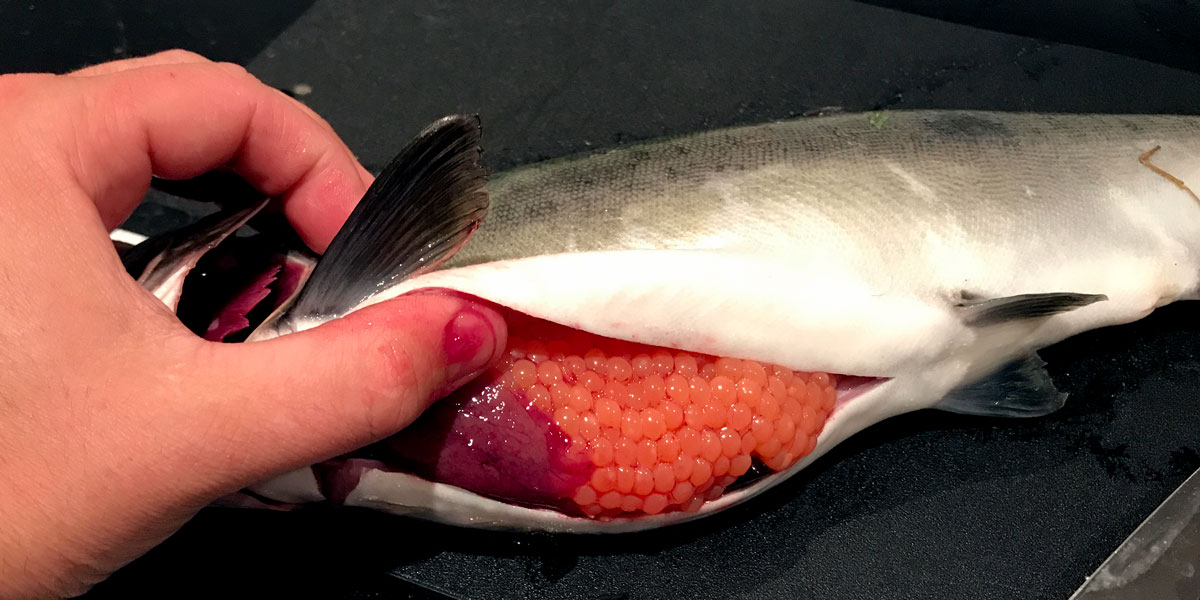Did you catch pink salmon this summer? NINAs researchers would like to hear from you. Send an email to laks@nina.no. The most important information is date, location, length, weight, and preferably a scale sample and a photo. Photo: Kim Andre S. Herstad.
Pink salmon is a species of Pacific salmon (genus Oncorhynchus) which has their natural distribution on either side of the northern Pacific Ocean. In the 1960s, pink salmon were found in rivers of Finnmark County in Norway following introductions to Russian rivers on the Kola pensinsula. Today, pink salmon are regularly caught in rivers in Finnmark County, near the border to Russia, and successful spawning has been registered in some rivers.
Catches of pink salmon occur annually in Norway, and most often in Finnmark County rivers. Stray individuals are caught occasionally to southernmost Norway. In the 1960s there were large catches of pink salmon along the Norwegian coast, but the catches have been reduced until recent years.
Register your catch
Eva B. Thorstad, a salmon researcher at NINA, is now collecting information on the distribution of pink salmon in Norway and would like to hear from anyone who has caught a pink salmon this summer.
- I have received messages about more than 200 pink salmon in ten days, from 50 rivers and the sea. Already, it is clear that the number of pink salmon is much higher than for many years, says Thorstad.
The reports come mainly from North Norway, Mid-Norway, and West Norway south to Rogaland County. There are fewer reports from southeastern Norway, but several have been caught in River Glomma near the southernmost border to Sweden.
- Most weigh 1-2 kg, and there is a little surplus of males (56% of those having been sexed). All of those that have been opened have plentiful of eggs or milt, and are ready to spawn this autumn.
Thorstad sends a warm thank-you to all of those who have contributed information on pink salmon catches, and wants more information sent to
E-mail: laks@nina.no
The most important information is date, location, length and weight. Preferably with a scale sample from the side of the fish below the two back fins, and a photo.
- If the fish is opened, we would also like to know its sex, and whether or not the fish would have spawned this year (in that case, the egg or milt sacks are large and nearly fill the body cavity), says Thorstad.
Scale samples can be sent to:
Eva Thorstad
Norwegian Institute for Nature Research (NINA)
PO Box 5685 Torgard
NO-7485 Trondheim
 The black dots on the caudal fin are a typical trait that distinguishes pink salmon from native Norwegian salmonids. Photo: Kim Andre S. Herstad.
The black dots on the caudal fin are a typical trait that distinguishes pink salmon from native Norwegian salmonids. Photo: Kim Andre S. Herstad.
More pink salmon in odd years
Why we see this increase of pink salmon abundance in 2017 is not known to researchers. Most likely the species have had very high survival during their oceanic life in the last generation.
All pink salmon have a short, two-year lifespan, and die after spawning in autumn. Following hatching in spring, the juveniles migrate rapidly to the ocean. In their second summer, they return to fresh water to spawn.
Fish that spawn in odd-numbered years (2011, 2013, 2015, 2017, etc) produce offspring that only spawn in odd years, and are thus reproductively isolated from fish that breed in even-numbered years in the same river. The pink salmon populations on the Kola peninsula are known to spawn in odd-numbered years, like this year.
 All pink salmon that have been registered so far have developed large gonads (egg or milt) and there is a risk that they will spawn in rivers this year. Photo: Kim Andre S. Herstad.
All pink salmon that have been registered so far have developed large gonads (egg or milt) and there is a risk that they will spawn in rivers this year. Photo: Kim Andre S. Herstad.
Alien species
Pink salmon are listed on the Norwegian Black List of alien species, categorised as having high risk for affecting native biodiversity in Norway. The juveniles leave rivers shortly after hatching in spring, so they are not expected to compete with native salmonids (Atlantic salmon, brown trout and Arctic charr) for space and food in the river. Negative effects can occur if they spawn in the same areas as native salmonids, or if they transfer fish diseases to local fishes.
- Spawning time is of vital importance, as we believe they spawn earlier than Norway’s salmonids, says Thorstad. The male pink salmon develop a characteristic ‘hump’ on the back (therefore the American name, humpback salmon) before spawning, but only a few photos during the last few days show this.
- Pink salmon are thought to spawn downstream in most rivers. So far, most reports are from the estuaries or downstream parts of rivers, but some are also caught further upstream.
More information
The Norwegian Biodiversity Information Centre has produced a factsheet on pink salmon in Norway (in Norwegian)
You can find more information in English on FishBase
 Sexually mature pink salmon males have a hump on the former part of the back, hence the name humpback salmon. Photo: Eva B. Thorstad/NINA.
Sexually mature pink salmon males have a hump on the former part of the back, hence the name humpback salmon. Photo: Eva B. Thorstad/NINA.
Pink salmon can be distinguished from Norwegian salmonids (Atlantic salmon, brown trout and Arctic charr) by their black spots on the tail fin and by the large oval black spots on the backside. Their scales are smaller than those of Atlantic salmon and trout, whereas a female pink salmon may resemble an immature Arctic charr. The latter, however, do not have black spots at all.
Contact: Eva B. Thorstad